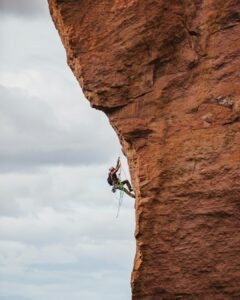Comprehensive Guide of Skydiving
Overview
Skydiving is an exhilarating adventure sport that involves jumping from an aircraft and free-falling before deploying a parachute to safely descend to the ground. This hobby offers a unique blend of adrenaline, freedom, and breathtaking views, making it a popular choice for thrill-seekers and those looking to conquer their fears. Skydiving can be experienced in various forms, including tandem jumps for beginners, solo jumps for licensed divers, and advanced techniques like wingsuit flying and formation skydiving. The experience of free-falling at speeds of up to 120 miles per hour provides an unmatched sense of exhilaration, while the peaceful descent under the parachute allows for reflection and appreciation of the landscape below.
History
The origins of skydiving can be traced back to the late 18th century when the first recorded parachute jump was made by André-Jacques Garnerin in 1797 from a hot air balloon in Paris. The sport evolved significantly during the 20th century, particularly during World War I and II, when parachuting became a crucial military skill. After the wars, skydiving transitioned into a recreational activity, with the establishment of the first skydiving clubs in the 1950s. The introduction of modern parachute designs, such as the ram-air parachute in the 1960s, greatly improved safety and maneuverability, making the sport more accessible. Today, skydiving is governed by various organizations that set safety standards and promote the sport worldwide.
Popularity and Demographics
Skydiving has gained immense popularity over the years, attracting individuals from diverse backgrounds and age groups. According to the United States Parachute Association (USPA), there are over 3 million jumps made annually in the U.S. alone, with thousands of new participants taking the plunge each year. The sport appeals particularly to young adults, with many first-time jumpers aged between 18 and 30. However, skydiving is also enjoyed by older enthusiasts, with many jumpers continuing to participate well into their 60s and beyond. The rise of social media has played a significant role in promoting skydiving, as stunning aerial photos and videos shared online inspire others to try the sport. Additionally, the availability of tandem jumps has made it easier for beginners to experience skydiving without extensive training, further contributing to its growing popularity.
Sponsored Hobbyists and Vendors
Become a Sponsor!
Affiliate Disclaimer: Throughout some sections below, Hobby Spotlight may suggest some tools, equipment or material using affiliate links. By purchasing any of those items, Hobby Spotlight may earn a small commission. This helps fund our website, content and services without directly charging our users.
Getting Started
Skydiving Equipment:
Beginner
- Tandem Skydiving Experience: A guided skydiving experience with an instructor.
- Skydiving Jumpsuit: A comfortable jumpsuit designed for skydiving.
- Skydiving Goggles: Protective goggles to shield your eyes during freefall.
- Altimeter: A device to measure altitude during the jump.
- Skydiving Helmet: A helmet designed for safety during skydiving.
Intermediate
- Skydiving Parachute: A personal parachute for experienced skydivers.
- Skydiving Rig: A harness and container system for carrying the parachute.
- Jump Logbook: A logbook to record jumps and progress.
- Skydiving Training Manual: A comprehensive guide for advanced skydiving techniques.
Basic Requirements and Initial Setup:
- Skydiving Gear: Essential equipment includes a parachute system (main and reserve), jumpsuit, helmet, goggles, and altimeter. Each component plays a critical role in safety and performance during the jump.
- Training and Certification: Before jumping, individuals must undergo training through a certified skydiving school. This includes ground school and tandem jumps, leading to a recognized certification like the A-License.
- Drop Zone Selection: Choose a reputable drop zone that offers experienced instructors, safety measures, and suitable facilities. Researching local options can enhance the overall experience.
Fundamental Skills to Learn:
- Body Positioning: Learning the correct freefall position (belly-to-earth) is crucial for stability and control during the jump.
- Altitude Awareness: Understanding altitude changes and using an altimeter to determine when to deploy the parachute is vital for safety.
- Emergency Procedures: Familiarity with emergency protocols, including how to handle a malfunctioning parachute, is essential for every skydiver.
- Landing Techniques: Practicing proper landing techniques helps reduce the risk of injury upon touchdown.
- Communication Skills: Effective communication with instructors and fellow jumpers enhances safety and coordination during jumps.
Sub-Hobby/Common Activities:
- Tandem Skydiving: A beginner-friendly option where a novice jumps with an experienced instructor, allowing for an exhilarating experience without extensive training.
- Formation Skydiving: Involves multiple jumpers working together to create formations during freefall, requiring teamwork and precise coordination.
- Wingsuit Flying: An advanced form of skydiving where jumpers wear a wingsuit to glide through the air, offering a unique flying experience.
- Canopy Piloting: Focuses on advanced parachute control and landing techniques, often involving speed and precision in landing accuracy.
- Skydiving Photography and Videography: Capturing the thrill of the jump through photos and videos, often requiring specialized equipment and skills.
Terminology:
- Freefall: The phase of the jump where the skydiver is falling without the parachute deployed, typically lasting around 30-60 seconds.
- Canopy: The parachute that opens after freefall, allowing for a controlled descent.
- Jump Run: The flight path taken by the aircraft to the drop zone, where jumpers exit the plane.
- Deployment: The process of opening the parachute, which must be executed at the correct altitude.
- Altitude: The height above ground level, crucial for determining when to deploy the parachute.
- Malfunction: Any issue that arises with the parachute during deployment or descent, requiring emergency procedures.
- Ground Rush: The visual perception of the ground approaching rapidly during freefall, often experienced by first-time jumpers.
- Static Line: A method of parachute deployment where a line attached to the aircraft automatically opens the parachute at a certain altitude.
- Jumpmaster: The person responsible for overseeing the jump, ensuring safety protocols are followed.
- Affiliation: The relationship between a skydiver and a specific skydiving organization or club, often providing access to resources and community support.
Advanced Topics and Specializations
Advanced Skydiving Equipment:
- Automatic Activation Skydiving Altimeter: A digital altimeter that automatically activates parachute deployment at a preset altitude, ensuring safety during jumps.
- Skydiving Helmet with Integrated GoPro Mount: A lightweight helmet designed for skydiving that includes a mount for action cameras, allowing for hands-free filming during jumps.
- Skydiving Jumpsuit with Aerodynamic Design: A jumpsuit made from lightweight, durable material that enhances aerodynamics and provides optimal performance during freefall.
- Skydiving Parachute System with RSL: A complete parachute system that includes a reserve static line (RSL) for automatic reserve deployment in case of main parachute failure.
Advanced Projects and Achievements:
- High-Altitude Jumps: Completing jumps from altitudes exceeding 15,000 feet, providing breathtaking views and extended freefall experiences.
- Formation Skydiving: Participating in organized jumps where multiple skydivers create intricate formations during freefall, showcasing teamwork and precision.
- Wingsuit Flying: Mastering the art of wingsuit flying, allowing for controlled gliding and extended flight time before parachute deployment.
Advanced Techniques and Methods:
- Canopy Control: Learning advanced techniques for maneuvering the parachute during descent, including turns, flares, and landing approaches.
- Freefall Tracking: Utilizing body positioning and movement to travel horizontally during freefall, optimizing distance covered before parachute deployment.
- Static Line Jumps: Executing jumps where the parachute is automatically deployed by a static line, ideal for beginners and training purposes.
Specializations and Niche Areas:
- Tandem Skydiving: Offering first-time jumpers the experience of freefall with an experienced instructor, ensuring safety and enjoyment.
- BASE Jumping: Engaging in jumps from fixed objects such as buildings, antennas, spans, and earth, requiring specialized skills and equipment.
- Skydiving Photography and Videography: Capturing the thrill of skydiving through aerial photography and video, providing memorable keepsakes for jumpers.
- Competitive Skydiving: Participating in competitions that test skills in accuracy landing, artistic freefall, and formation skydiving.
- Skydiving Safety and Instruction: Focusing on training and educating new jumpers on safety protocols and techniques.
Future Trends and Innovations:
- Increased use of advanced materials in parachute design for improved performance and safety.
- Growing popularity of indoor skydiving facilities, allowing for year-round training and experience.
- Integration of virtual reality technology for training simulations and enhancing the pre-jump experience.
- Development of automated parachute deployment systems for enhanced safety during jumps.
- Expansion of eco-friendly practices within the skydiving community, including sustainable gear and operations.
Technology Integrations:
- GPS Tracking Devices: Utilizing GPS technology to track jump paths and landing accuracy, enhancing training and performance analysis.
- Wearable Cameras: Using action cameras to capture immersive footage during jumps, allowing for personal documentation and sharing.
- Skydiving Apps: Mobile applications that provide jump logs, weather updates, and community engagement for skydivers.
- Drone Technology: Employing drones for aerial photography and videography, capturing unique perspectives of skydiving events.
- Online Training Platforms: Offering virtual courses and resources for aspiring skydivers to learn techniques and safety measures.
Further Learning and Resources
Books:
- The Skydiver’s Handbook by Brian Germain: An accessible guide for beginners that provides essential information on the fundamentals of skydiving, including jump planning and safety protocols.
- The Art of Flight by Tony Suits: An in-depth exploration of advanced skydiving techniques and maneuvers, ideal for experienced jumpers looking to enhance their skills.
Websites:
- USPA (United States Parachute Association), https://www.uspa.org – The official organization for skydiving in the U.S., providing resources, safety information, and a directory of drop zones.
- Skydiving.com, https://www.skydiving.com – A comprehensive site offering information on skydiving locations, tandem jumps, and training courses.
- Skydive Magazine, https://www.skydivemag.com – A publication dedicated to the skydiving community, featuring articles, news, and event coverage.
- Dropzone.com, https://www.dropzone.com – An online community for skydivers, offering forums, gear reviews, and a directory of drop zones worldwide.
- Skydiving Safety Foundation, https://www.skydivingsafetyfoundation.org – Focuses on promoting safety in skydiving through education and research.
Courses:
- Accelerated Freefall (AFF) Course, https://www.uspa.org/Training/AFF – A comprehensive training program for beginners to learn how to skydive solo.
- Skydive University, https://www.skydiveuniversity.com – Offers a variety of courses for all levels, including tandem jumps and advanced skydiving techniques.
- Skydive Academy, https://www.skydivingacademy.com – Provides structured courses for beginners and experienced jumpers, focusing on safety and skill development.
- iFLY Indoor Skydiving, https://www.iflyworld.com – Offers indoor skydiving experiences and training that can help beginners prepare for outdoor jumps.
- Advanced Skydiving Techniques Course, https://www.skydivingcourses.com – Designed for experienced skydivers looking to enhance their skills in specific areas such as formation skydiving and wingsuit flying.
Content Creators and Community
Content Creators:
- Skydive TV (YouTube): A channel dedicated to skydiving enthusiasts, featuring breathtaking jumps, tutorials, and insights into the skydiving community.
- Skydiving (Instagram): An account showcasing stunning skydiving photos and videos from around the world, highlighting the thrill and beauty of the sport.
- Skydiving Live (Twitch): A live streaming platform where experienced skydivers share their jumps in real-time, providing tips and engaging with viewers.
Online Forums and Social Media Groups:
- Reddit – /r/Skydiving: A community for skydivers to share experiences, ask questions, and discuss gear and techniques.
- Facebook Skydiving Groups: Various groups where skydivers connect, share photos, and organize jumps together.
- Skydiving Forums: Dedicated online forums for discussions on gear, safety, and skydiving events.
- Instagram Hashtags (#skydiving, #skydivinglife): Follow these hashtags for inspiring skydiving content and community engagement.
- Pinterest Boards: Explore boards filled with skydiving tips, gear recommendations, and breathtaking jump photography.
Local Clubs and Organizations:
- Skydiving Centers: Many regions have local skydiving centers that offer training, community events, and group jumps.
- Skydiving Associations: Organizations that promote safety, training, and community among skydivers.
- Local Adventure Clubs: Many adventure clubs include skydiving as part of their activities, providing a social aspect to the sport.
- Meetup Groups: Platforms like Meetup.com host local skydiving groups for enthusiasts to connect and plan jumps.
- Skydiving Competitions: Local competitions that encourage skill development and camaraderie among skydivers.
Events, Meetups, and Conventions:
- National Skydiving Championships: An annual event where skydivers compete in various disciplines, showcasing their skills and techniques.
- Skydiving Festivals: Events that bring together skydivers for fun jumps, parties, and networking opportunities.
- Safety Seminars: Workshops focused on safety practices and advancements in skydiving technology.
- Skydiving Expos: Events featuring vendors, gear showcases, and educational sessions for skydiving enthusiasts.
- Group Jumps and Meetups: Organized events where skydivers gather to jump together, fostering community and shared experiences.
Associated Hobbies
- Paragliding: Similar to skydiving, paragliding allows enthusiasts to experience the thrill of flying. It involves launching from a hill or mountain and gliding through the air, offering breathtaking views and a sense of freedom.
- Bungee Jumping: For those who crave adrenaline, bungee jumping provides a thrilling experience of free-falling from a height, often with a bungee cord attached. It complements the skydiving experience by offering a different perspective on gravity and thrill.
- BASE Jumping: This extreme sport involves jumping from fixed objects such as buildings, antennas, spans (bridges), and earth (cliffs). It requires a different set of skills and equipment compared to traditional skydiving.
- Hang Gliding: Like paragliding, hang gliding involves flying through the air using a lightweight, non-motorized glider. It offers a unique experience of soaring and gliding, often from elevated terrains.
- Aerial Photography: Many skydivers take up aerial photography to capture stunning views from above. This hobby combines the thrill of skydiving with the art of photography, allowing for unique perspectives of landscapes and events.
- Skydiving Gear Maintenance: Enthusiasts often take pride in maintaining their skydiving gear, including parachutes and harnesses. This hobby involves learning about the equipment, ensuring safety, and enhancing performance.
- Skydiving Instruction: Experienced skydivers may choose to become instructors, sharing their passion and knowledge with newcomers. This involves training others in safety protocols, techniques, and the joy of skydiving.
- Traveling for Skydiving: Many skydivers enjoy traveling to different locations for jumps, exploring various drop zones around the world. This hobby combines adventure with travel, allowing enthusiasts to experience diverse landscapes and cultures.
Cost and Budgeting
Initial Investment and Ongoing Costs:
- Initial Investment: The cost to start skydiving can vary significantly based on the type of training and equipment you choose. A tandem jump, which is often the first experience for beginners, typically costs between $200 and $300. If you decide to pursue a skydiving license, the Accelerated Freefall (AFF) course can range from $1,500 to $3,000, including training jumps and gear rental. Purchasing your own gear can add an additional $2,000 to $10,000, depending on the quality and type of equipment.
- Ongoing Costs: After obtaining your license, ongoing costs include jump tickets, which can range from $25 to $40 per jump, depending on the drop zone. Additionally, maintenance and replacement of gear, such as parachutes and altimeters, can incur costs of several hundred dollars annually. Insurance is also recommended, which can vary based on coverage and provider.
Budget-Friendly Options:
- Group Discounts: Many skydiving centers offer discounts for group bookings, making it more affordable for friends or family to jump together.
- Package Deals: Look for package deals that include multiple jumps or training sessions at a reduced rate, which can help lower the overall cost.
- Renting Gear: Initially, consider renting gear instead of purchasing it. Many drop zones offer rental equipment, allowing you to save money while you gain experience.
Where to Buy:
- Local Drop Zones: The best place to start is at local skydiving centers, where you can find training courses, gear rentals, and purchase equipment directly from knowledgeable staff.
- Specialty Skydiving Stores: Stores that specialize in skydiving gear offer a wide range of equipment, from parachutes to jumpsuits, and often have staff who can provide expert advice.
- Online Retailers: Websites like Skydive Gear and Paragear offer a vast selection of skydiving equipment, often at competitive prices, with the convenience of home delivery.
Money Making
How to Turn the Hobby into a Profession or Side Hustle:
- Skydiving Instructor: Obtain the necessary certifications to become a skydiving instructor. This role involves teaching new skydivers the basics of freefall and parachuting, ensuring they understand safety protocols and techniques. Instructors can work at established skydiving centers or start their own training programs.
- Skydiving Videographer: Combine your passion for skydiving with videography by becoming a skydiving videographer. Capture the exhilarating moments of tandem jumps and solo dives for clients, providing them with memorable footage of their experience. This role requires both skydiving skills and proficiency in video editing.
- Skydiving Equipment Sales: If you have expertise in skydiving gear, consider starting a business that sells skydiving equipment. This could include parachutes, jumpsuits, helmets, and other accessories. You can create an online store or partner with local skydiving centers to offer your products.
- Skydiving Event Organizer: Use your knowledge of the skydiving community to organize events such as competitions, festivals, or group jumps. This role involves planning logistics, securing sponsorships, and promoting the event to attract participants and spectators.
- Skydiving Travel Guide: If you enjoy traveling and exploring different skydiving locations, consider becoming a skydiving travel guide. You can create packages for skydivers looking to jump in various scenic locations around the world, providing them with a unique experience while earning a commission from travel bookings.
Benefits and Enjoyment
Physical, Mental, and Social Benefits:
- Physical Fitness: Skydiving requires a certain level of physical fitness, as it involves jumping from an aircraft and controlling your body in freefall. This activity can enhance core strength, flexibility, and overall body coordination.
- Mental Clarity: The adrenaline rush and focus required during a skydive can lead to improved mental clarity and heightened awareness. Many skydivers report a sense of euphoria and mental rejuvenation after a jump, which can help reduce stress and anxiety.
- Social Interaction: Skydiving is often a communal activity, bringing together individuals with a shared passion for adventure. Whether in training, during jumps, or at social events, skydivers form strong bonds and friendships, creating a supportive community.
Success Stories and Inspirational Examples:
- Felix Baumgartner: Known for his record-breaking jump from the stratosphere in 2012, Felix Baumgartner’s leap from 128,000 feet not only showcased the thrill of skydiving but also advanced scientific research on high-altitude jumps and human physiology.
- Jeb Corliss: A professional skydiver and BASE jumper, Jeb Corliss has inspired many with his daring jumps and innovative techniques. His passion for the sport has led him to create breathtaking videos that highlight the beauty and excitement of skydiving.
- Shannon McGrew: As a prominent figure in the skydiving community, Shannon McGrew has made significant contributions to the sport, including advocating for safety and training standards. Her journey from novice to experienced skydiver serves as an inspiration for many aspiring jumpers.
Ways to Enjoy and Grow in the Hobby:
- Take a Skydiving Course: Enroll in a certified skydiving course to learn the fundamentals and safety protocols. This structured training will enhance your skills and confidence, allowing you to enjoy the sport more fully.
- Join a Skydiving Club: Becoming a member of a local skydiving club can provide you with access to experienced instructors, group jumps, and social events. This community can offer support and camaraderie as you progress in your skydiving journey.
- Set Personal Goals: Challenge yourself by setting personal goals, such as completing a certain number of jumps, mastering new techniques, or participating in competitions. These goals will keep you motivated and engaged in the hobby.
Challenges and Solutions
Common Challenges Faced by Hobbyists:
- Fear and Anxiety: Many new skydivers experience fear or anxiety about jumping from an airplane. This can be a significant barrier to entry for those interested in the sport.
- Cost of Training and Equipment: Skydiving can be an expensive hobby, with costs associated with training, gear, and jump fees. This financial commitment can deter potential enthusiasts.
- Weather Conditions: Skydiving is highly dependent on weather conditions. Poor weather can lead to cancellations or delays, which can be frustrating for hobbyists eager to jump.
- Physical Fitness: While skydiving is accessible to many, certain physical requirements may limit participation. Individuals with specific health concerns may need to consult with a doctor before jumping.
Tips for Overcoming These Challenges:
- Take a Tandem Jump: For those feeling anxious, starting with a tandem jump can help ease fears. Jumping with an experienced instructor allows beginners to focus on the experience without the pressure of managing the jump alone.
- Budget Wisely: Plan your skydiving budget by researching costs and looking for package deals or discounts. Many drop zones offer special rates for first-time jumpers or group bookings.
- Stay Flexible: Be prepared for weather-related cancellations by having a flexible schedule. Consider booking jumps during off-peak times when weather conditions may be more favorable.
- Consult a Professional: If you have health concerns, consult with a medical professional who understands the physical demands of skydiving. They can provide guidance on whether it’s safe for you to participate.
Safety Considerations and Best Practices:
- Always complete a thorough pre-jump briefing with your instructor to understand the jump process and safety protocols.
- Ensure your equipment is in good condition and regularly maintained. Check your parachute and gear before every jump.
- Follow all instructions from your instructor and adhere to safety guidelines provided by the skydiving facility.
- Be aware of your surroundings during the jump, including other jumpers and landing zones, to avoid collisions.
- Practice good landing techniques to minimize the risk of injury upon landing. This includes proper body positioning and rolling upon impact.
Conclusion and Encouragement
Recap of Key Points:
- Skydiving offers an exhilarating experience that combines the thrill of freefalling with breathtaking views from high altitudes.
- Safety is paramount in skydiving; proper training and equipment are essential to ensure a safe and enjoyable jump.
- There are various types of skydiving, including tandem jumps for beginners and solo jumps for experienced divers, allowing everyone to find their niche.
- Skydiving can foster a strong sense of community, with many skydiving centers offering group jumps and events that connect enthusiasts.
- With advancements in technology, skydiving has become more accessible, with options for indoor skydiving and advanced parachute systems enhancing the experience.
Encouragement to Start and Enjoy the Hobby:
- Skydiving is an adventure that anyone can embark on, regardless of age or experience level. Many centers offer introductory courses that make it easy to get started.
- The rush of adrenaline and the sense of accomplishment after a jump are unmatched. It’s a perfect way to challenge yourself and step out of your comfort zone.
- Joining a skydiving community can enhance your experience. Meeting fellow enthusiasts and sharing stories can make your journey even more enjoyable and fulfilling.
Final Tips and Motivational Thoughts:
- Always prioritize safety by following all guidelines and instructions provided by your instructors. Never hesitate to ask questions if you’re unsure about anything.
- Embrace the learning process; every jump is an opportunity to improve your skills and gain confidence. Celebrate your progress, no matter how small.
- Consider documenting your skydiving experiences through photos or videos. Sharing your adventures can inspire others to take the leap and try skydiving themselves.

















